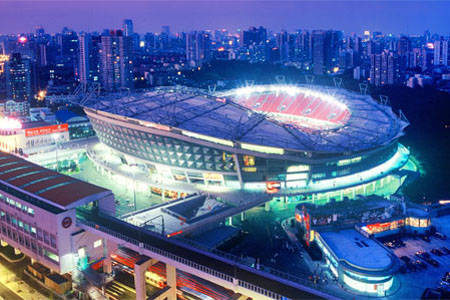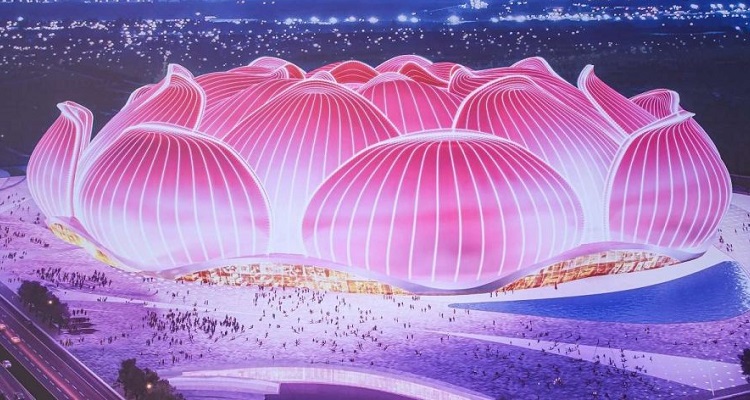With ambitions to be a football superpower and to host the FIFA World Cup as early as 2030, China is currently undertaking a multibillion-dollar burst of football stadium construction.
Aiming to have at least 12 major new football stadiums two years from now, said the state-run Southern Metropolis Daily, says that the work heralds "a new era for Chinese football".
The building spree, which is taking place despite the Coronavirus pandemic which has brought much of the world to a standstill, has this month seen work commence on a 12 billion yuan (US$1.7 billion) new home Chinese Super League (CSL) champions Guangzhou Evergrande - that will be world's biggest football stadium when complete.
While the Guangzhou venue is not scheduled to be among the 10 venues that will host fixtures during the 2023 AFC Asian Cup, its development is seen as a factor in China’s wider footballing ambitions, with China’s President Xi Jinping having previously expressed a desire for the world’s most populous nation to host the FIFA World Cup - potentially as early as 2030.
As Ji Yuyang, a journalist for the Oriental Sports Daily, suggested "I think China's desire to apply for the World Cup is very clear.”
FIFA President Gianni Infantino last June that he would welcome a Chinese bid to stage the 2030 World Cup, the next edition of the tournament for which hosting is available.
However, the 100,000 capacity of Guangzhou Evergrande's new stadium is seen as being too large for a club that averages about 50,000 for home matches.
As reported by AFP, Ji suggested "I think Evergrande may have two considerations. First, a 100,000-seat stadium might come in handy if China hosts a World Cup final or opening ceremony.
"Another point is that Evergrande will be able to make a statement by saying that they have the largest professional football stadium in the world, with the largest number of spectators."

With most stadiums currently used by Chinese football teams having been built for multiple sports and with poor facilities for fans, a new generation of contemporary and spectator friendly new venues is seen as fitting with President Xi's plan to transform the sport in the country on and off the pitch.
In Shanghai, which has ambitions of holding the Olympics, a 33,000-seat stadium for CSL side Shanghai SIPG is scheduled to be finished next year.
Shanghai Stadium, the biggest arena in the city and SIPG's former home, is also undergoing major renovation.
Ji said that while the Evergrande Group were likely paying for Guangzhou's new stadium, in some other instances it was a combination of the club and local government.
Professor Simon Chadwick, Director of the Centre for the Eurasian Sport Industry at Emlyon Business School, said that aside from China's World Cup aspirations, the rush on new stadiums sends a message that "China is developing and becoming healthier and stronger.
Professor Chadwick told AFP “there's something about the iconography and symbolism of the stadiums, particularly the Guangzhou development.
"This is a huge stadium, incredibly striking design, pictures of it have been carried across the world and people are commenting on it across the world.
"It's almost the soft power of stadiums. China is trying to use these hugely distinctive stadium designs as a way of attracting people and attention, of getting people to understand that China wants the same things that other countries want."
Images: The concept for the new stadium being built for Chinese Super League champions Guangzhou Evergrande (top) and Shanghai's Hongkou Football Stadium (below).
About the author
Nigel Benton
Co-founder/Publisher, Australasian Leisure Management
Nigel Benton is the co-founder and Publisher of Australasian Leisure Management, Australia and New Zealand’s only magazine for professionals in all areas of the leisure industry. Having established the magazine in 1997, shortly after his relocation to Australia, he has managed its readership rising to over 11,500 and its acceptance as the industry journal for professionals in aquatics, attractions, entertainment, events, fitness, parks, recreation, sport, tourism and venues.
In 2020, he launched the new Asian Leisure Business website.
Among a range of published works and features, his comments on a Blog (blogspot) from 2007 to 2011, when this website went live in its current form, may be interesting to reflect back on.
Click here to connect with him via LinkedIn.
Read more from this author
Related Articles
17th April 2020 - Construction starts on new Guangzhou stadium
31st March 2020 - Chinese authorities maintain spectator ban for major sports leagues
4th March 2020 - Coronavirus fears sees AFL cancel Shanghai fixture
13th February 2020 - Coronavirus fears sees postponement of F1 Chinese Grand Prix
12th February 2020 - Coronavirus continues to impact China’s sports events
12th February 2020 - US President Trump to attend inauguration of world’s largest cricket stadium during upcoming Indian visit
5th February 2020 - Shanghai Sports Federation suspends all sporting events casting doubt on F1 Grand Prix
15th July 2019 - Alipay unveils 1 billion yuan initiative to support women’s football in China
6th June 2019 - China named 2023 AFC Asian Cup hosts
27th March 2019 - White paper flags rise of Chinese Super League football
15th February 2019 - News report suggests few Chinese sports venues are profitable
12th February 2018 - China invested nearly US$3 billion in school football facilities from 2015 to 2017
12th January 2018 - Shanghai Municipality to build eight new professional sports stadia by 2035
28th November 2016 - China’s plan to massively expand its sports industry
30th September 2016 - China targets hosting of 2030 FIFA World Cup
16th March 2016 - Football attendances rise in China and India
13th March 2015 - China looks to football success and future FIFA World Cup hosting








